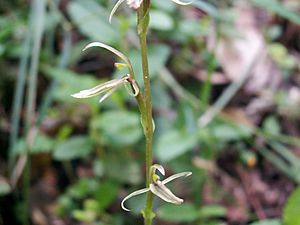Western gnat orchid facts for kids
Quick facts for kids Western gnat orchid |
|
|---|---|
 |
|
| Cyrtostylis huegelii near Mount Chudalup | |
| Scientific classification | |
| Genus: |
Cyrtostylis
|
| Species: |
huegelii
|
| Synonyms | |
The Cyrtostylis huegelii, often called the western common gnat orchid or midge orchid, is a special kind of orchid. It is endemic to Western Australia, which means it only grows there naturally. This orchid usually has one round leaf that lies flat on the ground. From this leaf, a stem grows with up to fifteen pale green and dull red flowers. Each flower has a unique purplish, shelf-like part called a labellum. Some scientists believe C. huegelii is actually a type of another orchid, Cyrtostylis reniformis var. huegelii.
What Does the Western Gnat Orchid Look Like?
The Western Gnat Orchid is a ground-dwelling herb. This means it grows in the soil and has soft stems, not woody ones. It is also a perennial plant, so it lives for more than two years. It is deciduous, meaning its leaves fall off at certain times of the year, usually when it's dry.
This orchid has a single, almost round leaf that hugs the ground. This leaf is usually 30–70 mm (1–3 in) long and 20–50 mm (0.8–2 in) wide.
A flowering stem grows from the plant, reaching 100–350 mm (4–10 in) tall. On this stem, you can find up to fifteen flowers. These flowers are usually pale green and fawn-coloured, or sometimes dull red. They are about 10–20 mm (0.4–0.8 in) long and 5 mm (0.2 in) wide.
Let's look at the parts of the flower:
- The dorsal sepal is the top part of the flower, like a hood. It stands upright and curves forward. It's about 10–14 mm (0.4–0.6 in) long and 2 mm (0.08 in) wide.
- The lateral sepals are the two side parts. They are 8–11 mm (0.3–0.4 in) long and about 1 mm (0.04 in) wide. They curve either forward or downward.
- The petals are similar in size and shape to the lateral sepals and also curve downwards.
- The labellum is a special lip-like part of the orchid flower. For the Western Gnat Orchid, it's purplish and shaped like a shelf. It's tapered (gets narrower at the end) and oblong, about 8–11 mm (0.3–0.4 in) long and 3 mm (0.12 in) wide. It has a pointed tip.
These orchids usually bloom, or flower, between July and September.
How Did It Get Its Name?
The Western Gnat Orchid was first officially described in 1846 by a scientist named Stephan Endlicher. He found a sample of the plant on Rottnest Island. His description was then published in a book called Plantae Preissianae by J.G.C. Lehmann.
The second part of its scientific name, huegelii (called the specific epithet), was chosen to honor Charles von Hügel. He was the person who collected the very first sample of this orchid, which is known as the type specimen.
It's interesting to know that some plant experts think C. huegelii is actually a synonym (another name for the same thing) of C. reniformis var. huegelii. This means they believe it's just a variation of a different, similar orchid.
Where Does This Orchid Live?
The Western Gnat Orchid grows in different types of natural areas in Western Australia. You can find it in:
- Shrubland: Areas with many shrubs and bushes.
- Woodland: Areas with trees that are not too close together, allowing sunlight to reach the ground.
- Forest: Denser areas with many trees.
It prefers the wetter parts of Western Australia. You can also find it growing on granite outcrops, which are large areas of exposed granite rock, especially in more inland (further from the coast) regions.
This orchid is found across a wide area of Western Australia, from Kalbarri in the north down to Esperance in the south.

